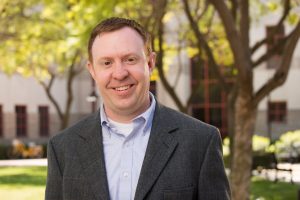
To Patrick Mason, The Church of Jesus Christ of Latter-day Saints is the most prominent religious tradition to come out of the Burned-over District.
“I’ll be talking about the transformation of Mormonism from very humble origins in Western New York in the 1820s, to the worldwide religion that it is today,” said Mason, an author, historian and Leonard J. Arrington Endowed Chair of Mormon History and Culture at Utah State University. “I hope people gain an appreciation for this really surprising religious movement that starts with a farm boy in New York.”
At 2 p.m. Tuesday, July 23 in the Hall of Philosophy, Mason will discuss “Mormonism: From the Burned-Over District to a New World Religion” as part of the Week Five interfaith theme, “Chautauqua: Rising from the Ashes of the Burned-Over District.”
The Burned-over District refers to western regions of New York State that, in the 19th century, experienced religious revivals and movements of the Second Great Awakening.
Mason said that while the Mormon church had a relatively modest effect in the Burned-over District itself, it quickly gained traction and moved west to Utah.
“I think it’s emblematic of the Burned-over District — it comes out of that milieu,” he said. “But it doesn’t have the same transformational effect on the Burned-over District as other forms of evangelical Protestantism. It comes out of that environment, and has the Burned-over District stamped all over it in terms of its origins.”
According to Mason, the Mormon church began when a young farmer named Joseph Smith, as he described it, saw the “first vision” of God.
“He organized his church in 1830, but a year after that the church moved out of New York to a new home in Ohio and Missouri,” Mason said. “And it’s because Joseph Smith didn’t feel safe (in New York). He and the other converts were being persecuted and receiving threats of violence that had happened ever since he reported his initial visions.”
Mason said it was ironic Smith was forced to leave Western New York because of religious persecution, since the western part of the state was populated by people who left eastern New York and New York City to find more religious freedom.
“Another irony is that Joseph Smith and the early Mormons felt like they were trying to settle the religious debate,” he said. “The religion came about because there was a cacophony of religious voices in the region. Smith wanted to settle the problem once and for all by an appeal to revelation and heaven itself, and of course all he does is create yet another religion that added to the cacophony, rather than muting it.”
The very existence of The Church of Jesus Christ of Latter-day Saints is fascinating to Mason, a fascination he said he wants to share with his lecture audience.
“For me, it’s one of the surprises of history,” he said. “I think about just how dynamic and formative the Burned-over District was and continues to be, even 200 years later.”




